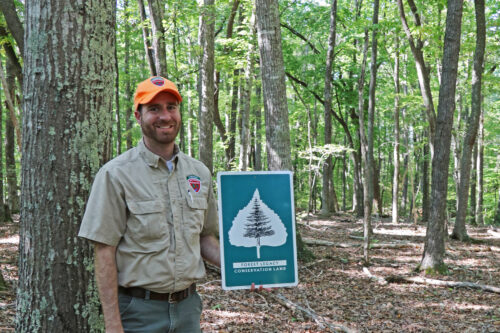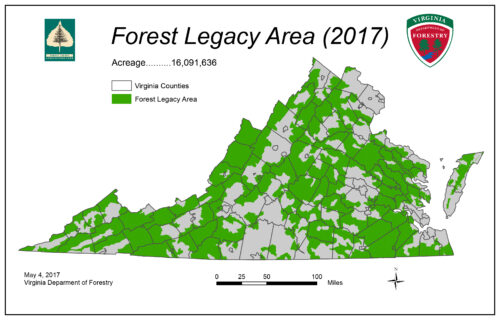 The federal government established the Forest Legacy Program (FLP) with the intent to partner with state agencies to protect important forestlands under threat of conversion to other uses. This USDA Forest Service program uses federal grant funding to support state efforts to identify and protect important private forest tracts threatened by conversion to non-forest uses.
The federal government established the Forest Legacy Program (FLP) with the intent to partner with state agencies to protect important forestlands under threat of conversion to other uses. This USDA Forest Service program uses federal grant funding to support state efforts to identify and protect important private forest tracts threatened by conversion to non-forest uses.
FLP funding helps states purchase land or conservation easements to protect forestlands that provide public benefits, including sustainable forest resources, clean water and air, wildlife habitat, and forested scenic views, as well as protect sensitive sites and essential habitat for threatened and endangered species.
If you are interested in the Forest Legacy Program, read the information below in detail, and if you’d like to apply, e-mail the Forestland Conservation Program.
Read more about threats to Virginia’s forestland base and how the Virginia Department of Forestry works to conserve forests.
Forest Legacy Program in Virginia
The Virginia Department of Forestry (VDOF) is the state lead agency responsible for managing the program and associated federal grant funds for the conservation of important forestlands in the Commonwealth. The program continues to be an important part of Virginia’s land conservation efforts.
One of the primary tenets of the FLP in Virginia is to ensure the conservation of working forests that provide the multiple benefits to Virginians. Diverse, well-managed working forests are the healthiest and most productive; consequently, they provide the most public benefit when protected from the economic pressure for development.
During the program’s first 21 years in Virginia, through December 2020, FLP funding supported the conservation of 25 tracts totaling 21,799 acres.
Eligibility and Potential Award Benefits
To most effectively utilize limited resources, the FLP focuses on priority areas in the state that meet program eligibility criteria and possess the highest conservation value. Such criteria include the threat to conversion, presence of natural heritage resources, production of forest products, and watershed resources. To be eligible for the FLP, land must be located within the Forest Legacy Area for Virginia.
The FLP pays up to 75% of the appraised value for conservation easement or fee interest tracts, with the required matching funds coming from private, state, or local sources. Landowners may benefit from reduced taxes if they choose to donate the required matching funds for the program by accepting what is called a bargain sale. For lands being offered for a conservation easement, a multiple-resource forest management plan must be developed or updated prior to award payout.
To Apply
Landowner Application and Deadlines
Landowners interested in the Forestry Legacy Program must prepare an application for the program and also choose a Project Advocate to research the property’s amenities, prepare a proposal and a GIS-quality map, and possibly combine several properties together in an effort to increase the competitiveness of the application.
The Project Advocate is typically a land trust or other private land conservation organization, but may also be the land conservation staff of a governmental entity or any other interested organization. These organizational entities typically have staff and resources that allow for the enhanced proposal development necessary to secure funding in this competitive process.
Applications open in March and are typically due to VDOF by July. For specific deadlines and application requirements, refer back to this page or e-mail us.
Application Review and Ranking
Project Proposals received each year are reviewed and ranked by a four-member Forest Legacy Subcommittee, confirmed by the state’s full Forest Stewardship Committee, and presented to the State Forester for nomination of the top three Virginia proposals for national ranking.
A panel of FLP personnel from across the nation determine a national project ranking, which is considered by the President and by Congress during federal budget deliberations. Highly-ranked proposals receive funding (or partial funding) in the Appropriations Act.
Additional Resources
[posts_table columns="image,title:Title,cf:id_number:ID,content:Description,tax:Media,button" post_type="document-library" rows_per_page="5" exclude_term="Audiences:no, Media:news-releases" term="document-tags:forest-legacy" filters="tax:document-category:Select Category,tax:Media:Select Content Type" search_box="true" reset_button="true"]Contact Us
For more information or questions, e-mail us or use our contact form.

